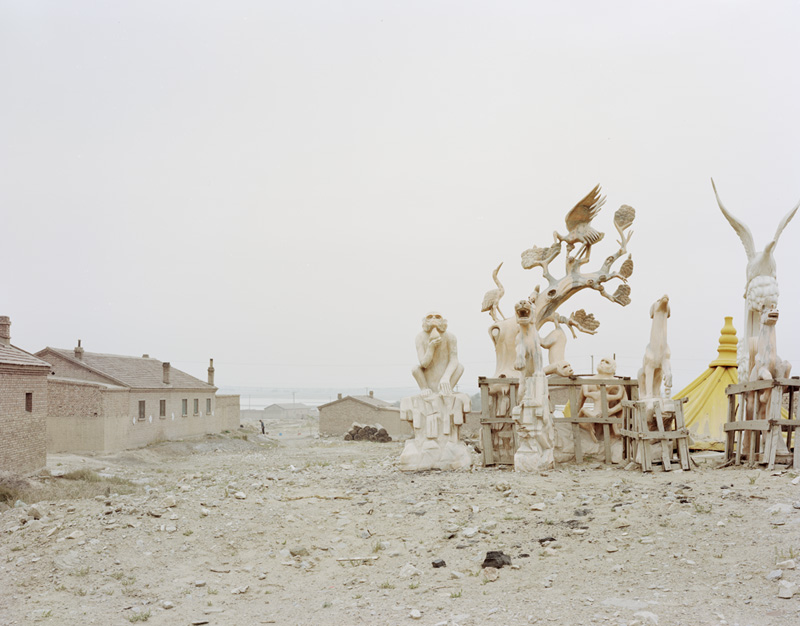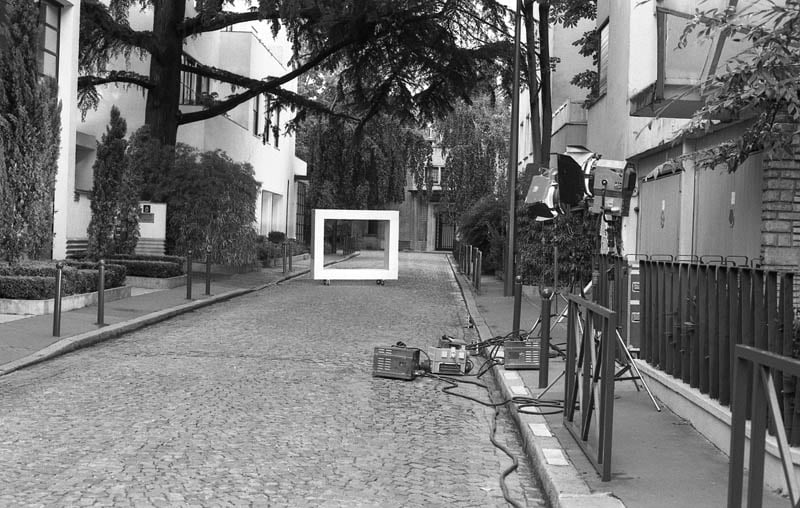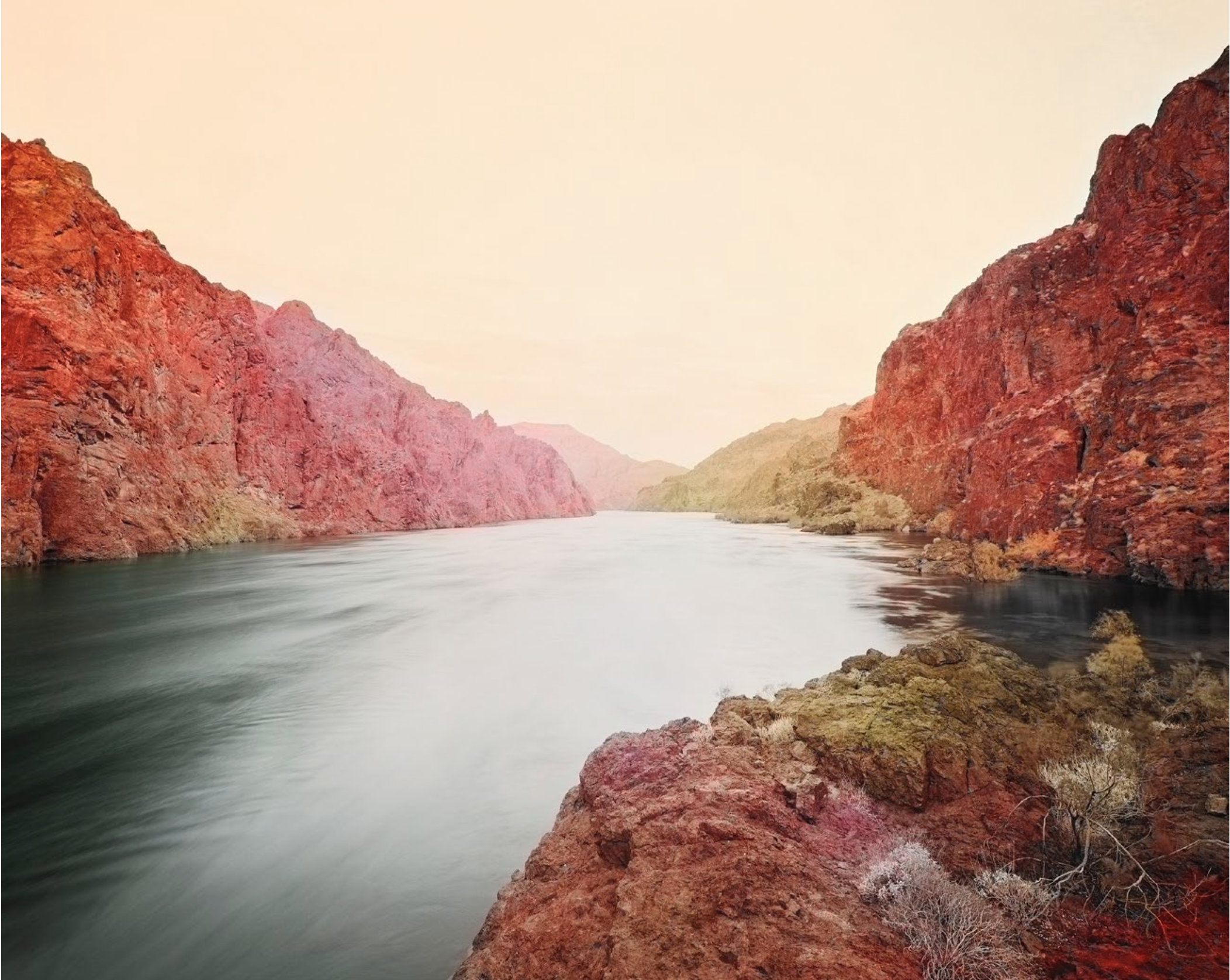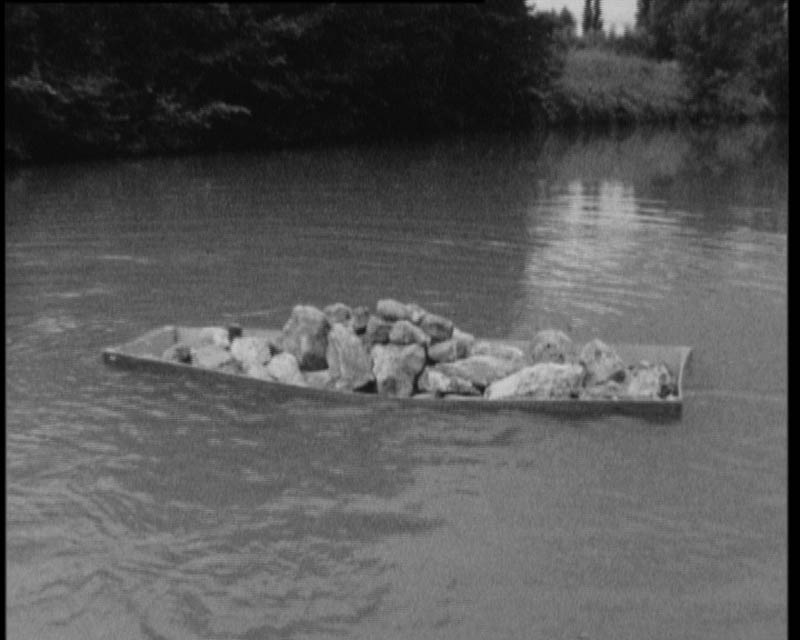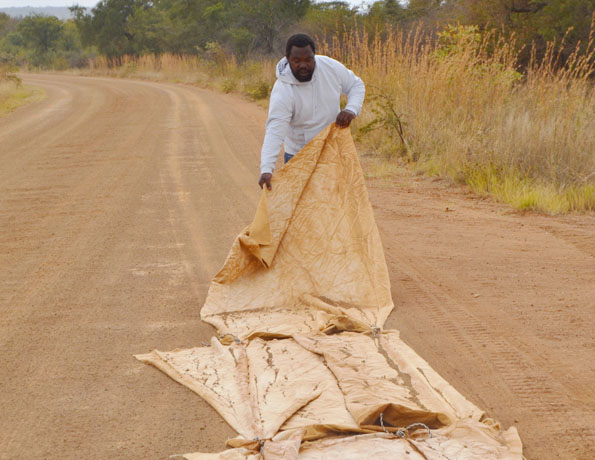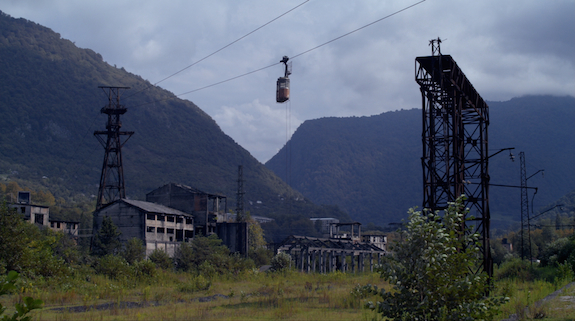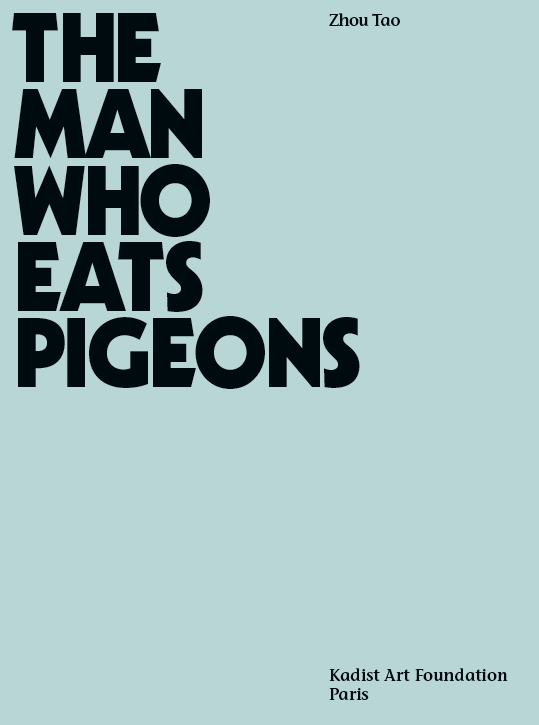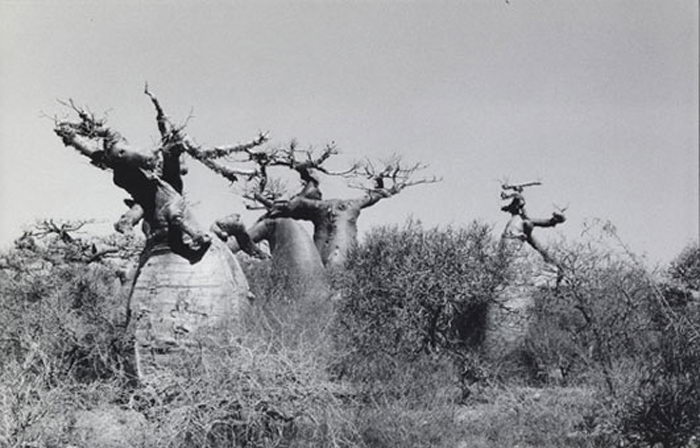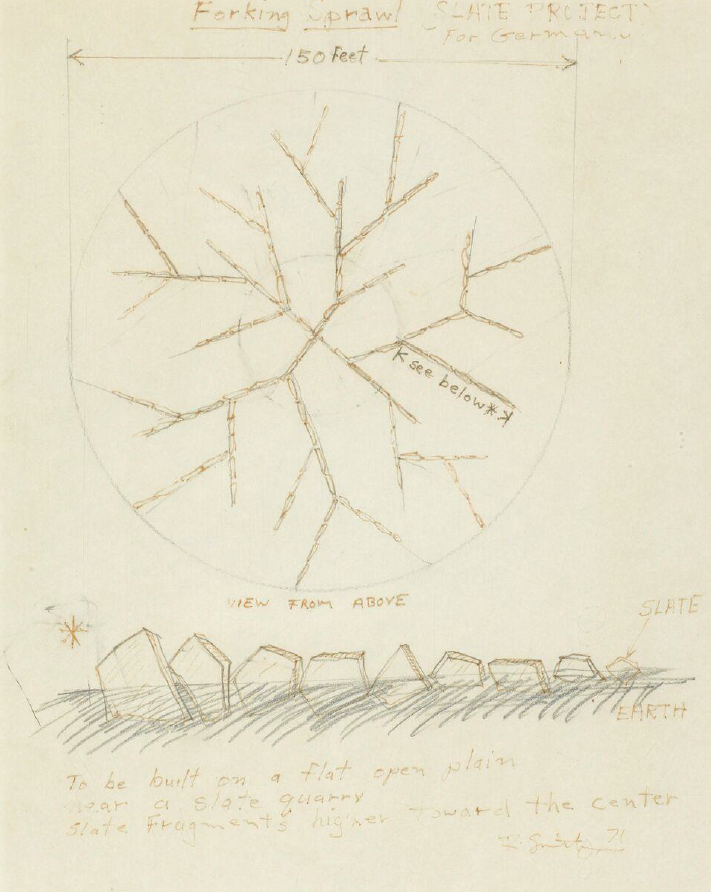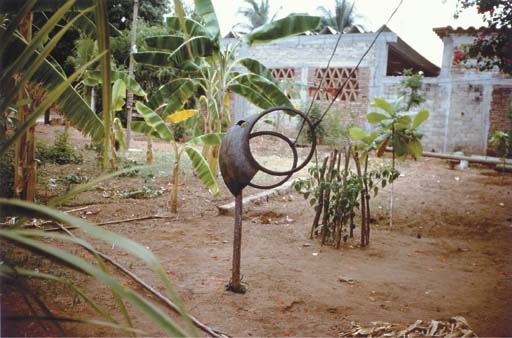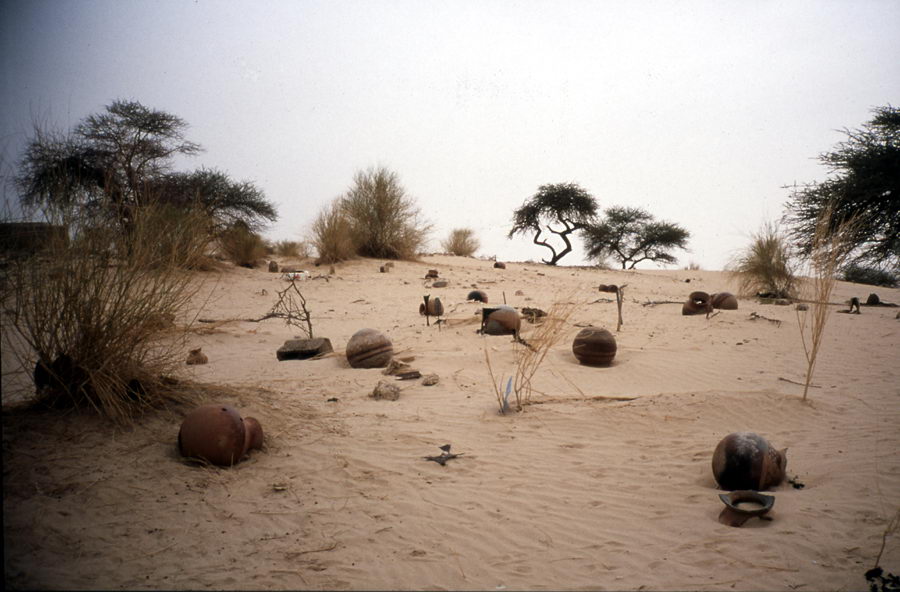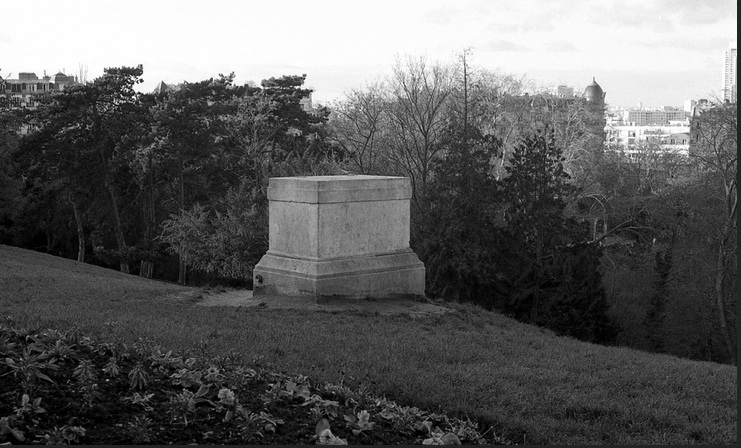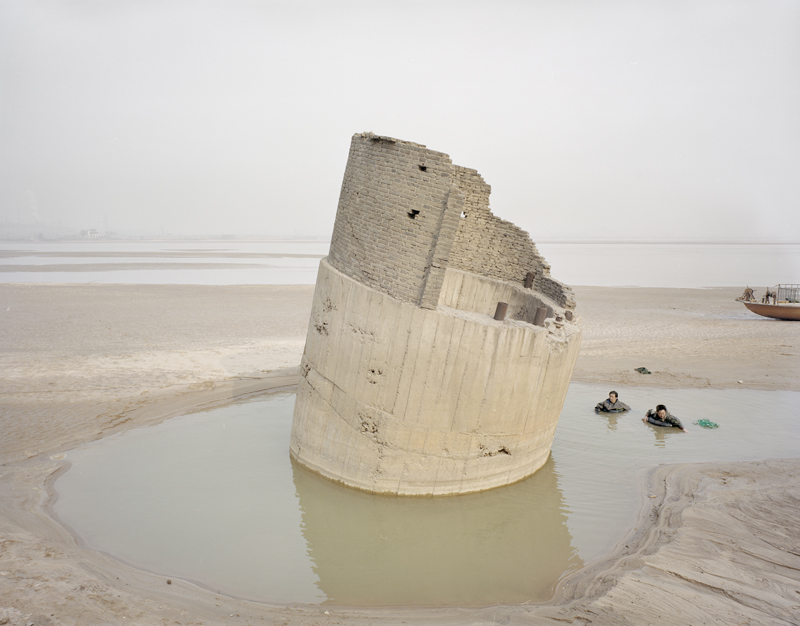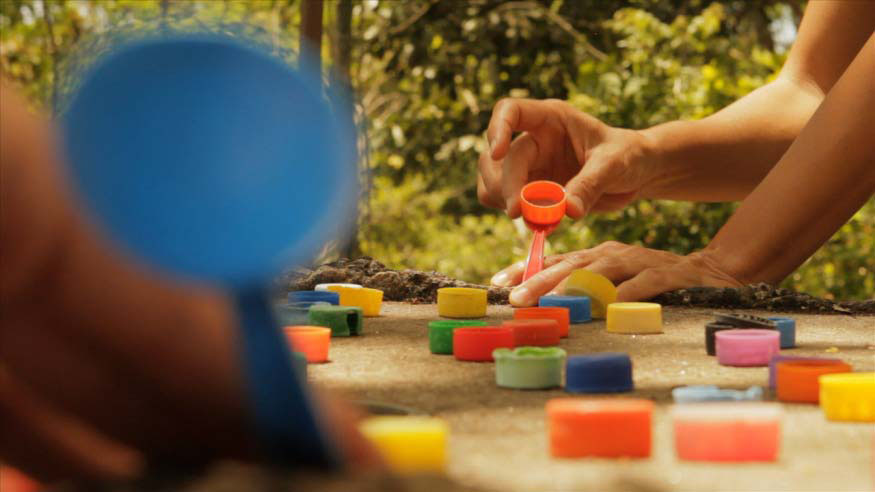
© » KADIST
Nontawat Numbenchapol
The series of prints titled Mr. Shadow by Nontawat Numbenchapol engages with the history of and current state of militarization in Thailand. Each print features an invisible person, their silhouette only outlined by the military fatigues that they wear.

© » KADIST
Leticia Ramos
Leticia Ramos’s film DROPSPIKE is the second of a five-part film project entitled STORIES OF THE END OF THE WORLD . Each film in the series takes place in a different part of the world where climate change modifies the landscape. The short 16mm film was mostly shot during Ramos’s residency at La Bacque in Switzerland.

© » KADIST
Nontawat Numbenchapol
The series of prints titled Mr. Shadow by Nontawat Numbenchapol engages with the history of and current state of militarization in Thailand. Each print features an invisible person, their silhouette only outlined by the military fatigues that they wear.

© » KADIST
Michael Armitage
In “And so it is” shows the image of a faceless man before a microphone, ready to deliver an important message. The viewer is faced with the familiar image of political power seen in our homes on the television, yet this time located in a whimsical abstract landscape. The speaker appears as a shadow in front of a crowd that is responding to him by holding bubbles containing images of animals and plants.

© » KADIST
Ayan Farah
The painting is composed of nineteenth century linen collected over five years. The pieces started out as offcuts from a large work called Fabaceae, which refers to the carob bean, an African staple found in the rainforest and tropical forests. The artist took these already dyed offcuts and dyed them further and then put them out in the sun to fade.

© » KADIST
Calderón & Piñeros (La Decanatura)
Calderón & Piñeros (La Decanatura) refer to Sólheimasandur as a work that tackles the issue of “the ruin as a tourist destination.” As they say, “at the end, tourists become an essential part of this unusual, beautiful, and—at the same time—banal landscape.” The video features a plane wreck on Sólheimasandur beach in Iceland, where a navy plane belonging to the United States Army crashed in 1973 due to fuel exhaustion. The plane appears as an anthropomorphized figure: lying on the sands of the beach without its wings, it resembles a sculptural torso that has lost all its limbs, with cables coming out of its body appearing as internal organs. These injuries remind the viewer of the danger inherent in these artifacts, and the potential for both heroism and death implicit in flying them to far-away territories.

© » KADIST
Jarrett Key
Jarrett Key’s practice combines several modes of production into a single frame, incorporating sculpture, painting, and performance. Dancing Free I , painted in wet cement, like a fresco, is part of a current series of paintings titled Leaving the City , which depicts Black people they know in lush, pastoral landscapes. Raised in rural Alabama, Key’s series grew out of a few experiments conducted with visitors to their studio.

© » KADIST
Vivian Suter
Vivian Suter paints her canvases and then allows them to come in contact with natural elements. For thirty years she has lived in isolation in the Guatemalan jungle, accumulating canvases, sometimes leaving them out for long periods of time. As a result, Suter does not title or date her paintings.

© » KADIST
Sam Contis
Sam Contis’s photographs explore the relationship of bodies to landscape, and the shifting nature of gender identity and expression. Oil is part of a photographic series Contis made at Deep Springs College, one of the United States’s last all-male institutions of higher learning, located in a remote desert valley on the California–Nevada border. Oil features a hand in front of an open hood of a car, checking the oil.
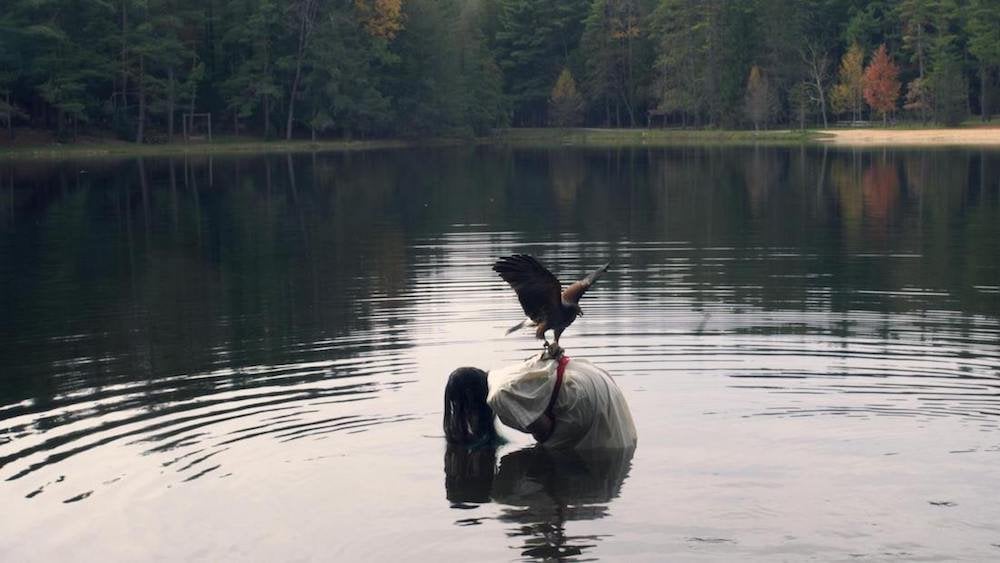
© » KADIST
Alicia Smith
The title of Alicia Smith’s video work, Teomama , means “God Carrier” in the Aztec language of Nahuatl. It was the name given to medicine men and women who carried the bones of Huitzilopochtli—the god of war, sun, and human sacrifice in ancient Mexico, and the national deity of the Aztecs. Of the many legends featuring Huitzilopochtli, the origin story of Tenochtitlan (present day Mexico City) is perhaps one of the most well-known.

© » KADIST
Nontawat Numbenchapol
The series of prints titled Mr. Shadow by Nontawat Numbenchapol engages with the history of and current state of militarization in Thailand. Each print features an invisible person, their silhouette only outlined by the military fatigues that they wear.

© » KADIST
Rahima Gambo
“ I think we are oversaturated, filled to the brim with images in our inner subconscious eye. Towards the end of 2020, I was feeling very much that I couldn’t take in any more information visually. That was when I made Instruments of Air.

© » KADIST
Hoda Afshar
In the islands of the Strait of Hormuz off the southern coast of Iran, a distinctive local culture has emerged as the result of many centuries of cultural and economic exchange, the traces of which are seen not only in the material culture of these islands but also in the customs and beliefs of their inhabitants. Central to these is a belief in the existence of winds—generally thought of as harmful—that may possess a person, causing her to experience illness or disease, and a corresponding ritual practice involving incense, music and movement in which an hereditary cult leader speaks with the wind through the afflicted patient in one of many local or foreign tongues in order to negotiate its exit. While their exact origins are unclear, the existence of similar beliefs and practices in many African countries suggests that the cult may have been brought to the south of Iran from southeast Africa through the Arab slave trade.

© » KADIST
Robert Zhao Renhui
Changi, Singapore, possibly 1970s is from the series “As We Walked on Water” (2010-2012), which looks into Singapore’s history around the phenomenon of land reclamation. After exhausting the country’s own soil from its tiny hills and ridges, the government had to buy sand from Malaysia and Indonesia to continue its reclamation efforts. At the early stages of a land reclamation project, the imported sand would sit idle for some time, forming an artificial desert-like landscape.

© » KADIST
Dannielle Bowman
Vision (Bump’n’Curl) by Dannielle Bowman is from a series of photographs titled What Had Happened . The series blends a major historical event with small, personal images. The photographs retain fragments of the artist’s own heritage and investigate the concept of home, while gaining inspiration from the Great Migration, a movement in which African Americans from the South (including Bowman’s grandparents) moved to the North, and also the American West from 1916-1970.
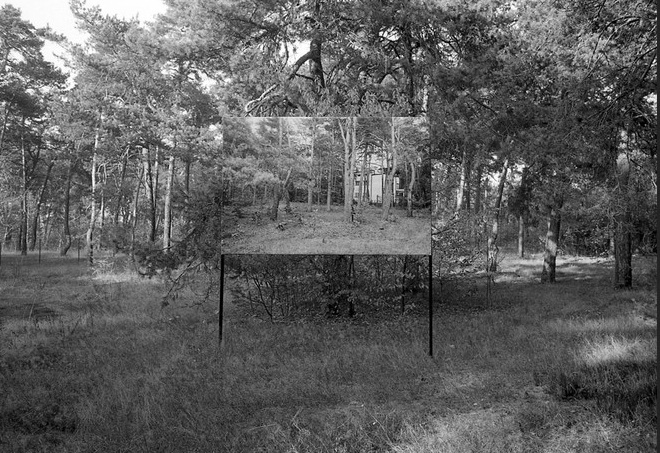
© » KADIST
Charlotte Moth
It is with the eye of a sculptor that Charlotte Moth records modernist architecture and its copies which she encounters during her trips and residences. Photographed in black and white, these architectures seem empty, out of time, and open to any interpretation. The artist creates a classification of her species of spaces, called the “Travelogue”, which is both artwork and tool since it allows her to ceaselessly generate new works.

© » KADIST
Motoyuki Shitamichi
Motoyuki Shitamichi launched his Torii project in 2006. He proceeded to visit and photograph torii that are situated outside Japan’s current national border. Expansionist Japan constructed numerous torii during its occupation of the Northern Mariana Islands (now a U. S. territory), Northeast China (former Manchuria), Taiwan, South Korea, and Sakhalin (the eastern most area of Russia).
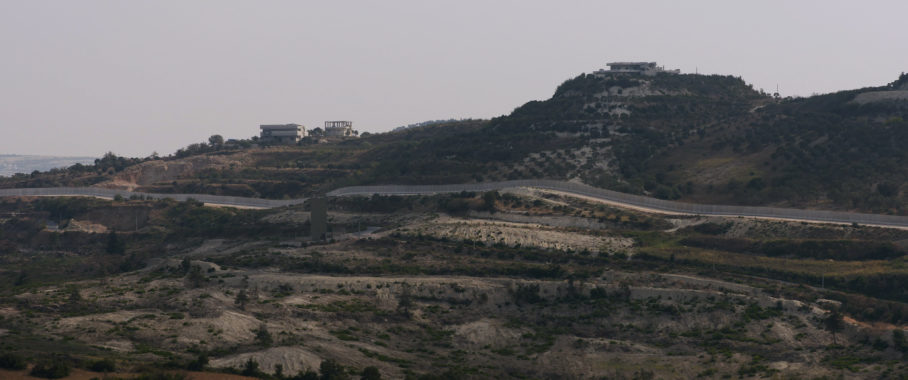
© » KADIST
Eric Baudelaire
Baudelaire’s latest film, Also known as Jihadi (2017) tells the story of a young French boy from Parisian suburbs and his assumed journey to the Al-Nusra front in Syria to join ISIS and fight Bashar al-Assad’s regime. Employing the cinematographic approach known as ‘landscape theory’ — or fûkeiron — developed out of Marxist film criticism in the 1970s where the landscape of a film is read as an expression of the political climate, thus becoming a significant character, motivation or reasoning for the films development. The 101-minute follows Abdel Aziz from the socially and politically rife milieu of the Parisian suburbs, weighted by division, segregation, development and poverty to, what the viewer assumes, Syria.

© » KADIST
Zhang Kechun
Zhang Kechun’s photographic series The Yellow River documents the effects of modernization along the eponymous Yellow River, the second longest in Asia. The Yellow River is considered the cradle of Chinese civilization but also poses a great threat, as the river is capable of breaking its banks at any time. Inspired by the novel River of the North by Zhang Chengzhi, the artist travelled on a fold-up bicycle through eastern China’s Shandong province, where the river discharges vast amounts of water into the sea, before slowly tracing it westward over several month-long trips heading to the river’s source near the Bayan Har Mountain in Qinghai.

© » KADIST
Lam Tung Pang
Drawing & Print (Drawing & Print)
Lam Tung Pang created Sketches from train ride Chicago to San Francisco during his travels through the United States researching American curatorial strategies for representing traditional Chinese painting in museums and cultural institutions. The drawings incorporate both traditional and contemporary Chinese landscape techniques to reflect on the memory, history, and aesthetic practices of the Chinese laborers who played a prominent role in the American westward expansion. By representing the Western landscape according to Chinese aesthetics, Lam calls attention to the distortions and cultural specificity of American representations of the Western landscape and non-Western cultures.

© » KADIST
Nguyen Trinh Thi
Landscape Series no. 1 presents landscape as a “quiet witness of history.” It began with searches of online archives of Vietnamese news-media, for images of figures in landscapes “pointing, to indicate a past event, the location of something gone, something lost or missing.” The uniformity is striking but the sequence is subtly structured: the typology hints at narrative progression, though of an uninformative narrative, lacking details.

© » KADIST
Elena Damiani
Intersticio (Interstice) by Elena Damiani traces the topography of a non-specific site, an in-between zone. The video presents a panoramic view of two territories of a shifting and unresolved character, composed out of segmented events that visually intersect at a shared horizon point. Over the images, a fragmented and ambiguous poetic narration describes, by means of images found in digital archives, a hybrid site that permutes the representation of nature through its fusion of source material.
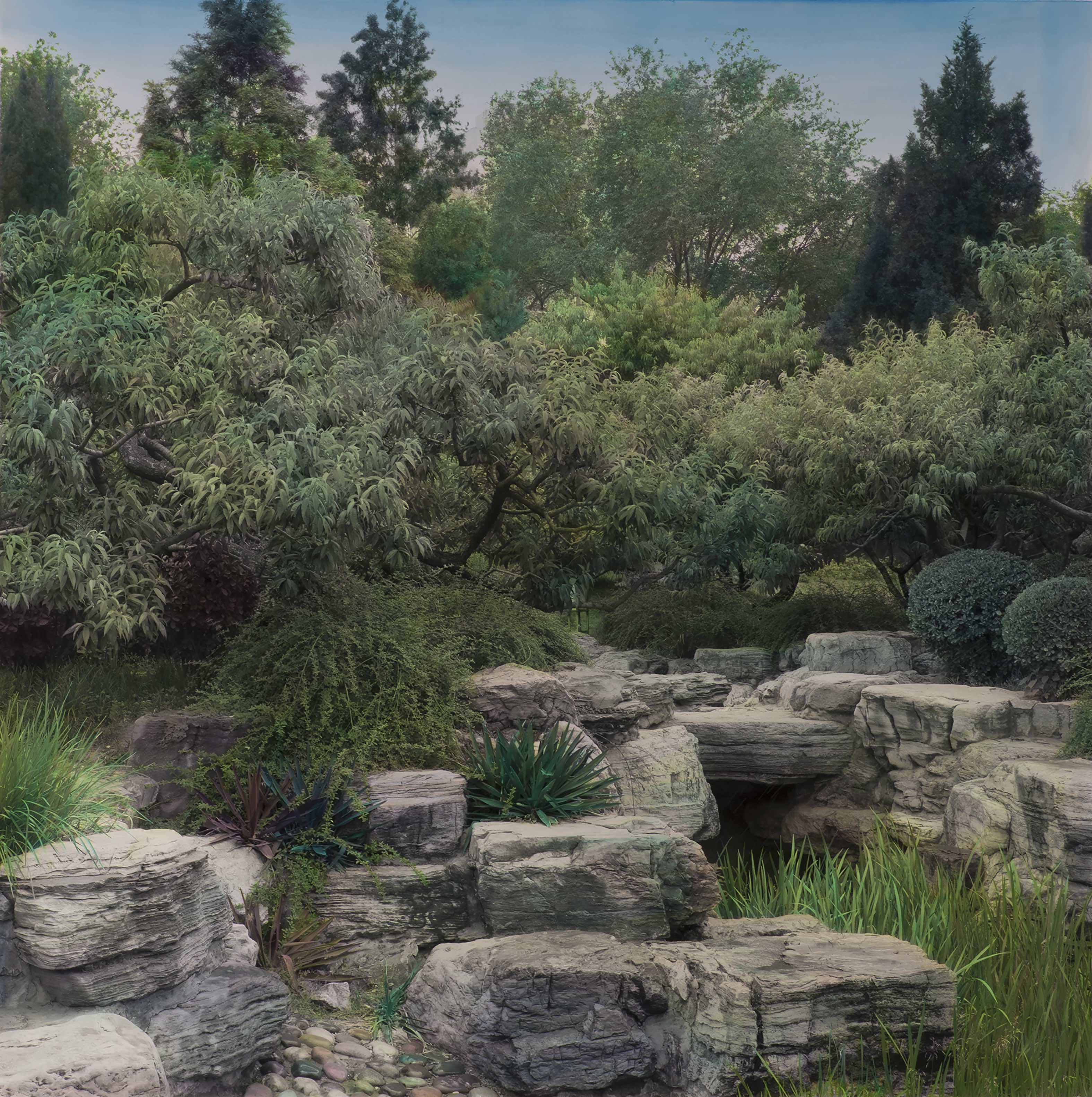
© » KADIST
Shi Guowei
Through a hand-painting process, Shi Guowei created Manufactured Landscape . At first glance, the painting appears from afar as a landscape photograph. Yet, upon closer attention, the work reveals itself as a landscape painting thoroughly hand-colored by the artist onto a photograph.

© » KADIST
Ruijun Shen
In Seven Deadly Sins (2006), Shen utilizes abstraction to produce complex topographies of color that evoke associations with violently tumultuous landscapes. Streaks of blue and burgundy paint scatter across a peach colored silk backdrop, dripping into rough floral and botanical forms. At once both diffuse and dense, Shen’s compositions feel both expansive and contained, the colors overlaid atop another with a seemingly free spontaneity that belies more ordered and considered deliberation.

© » KADIST
Jiri Kovanda
Kovanda’s street interventions are always documented according to the same format as the actions: a piece of A4 paper, a typewritten text giving a precise location and date, and a photograph. Contrarily to the actions, he took the photographs himself. One of the rules he stuck to in his artistic practice was to always use material at his disposal, a real economy of means.

© » KADIST
Raphaël Zarka
This photograph seems to be awaiting meaning, it more or less evokes known elements without really identifying with them completely: a motorway interchange, a bridge, an electric pylon… In fact this is the end of the tracks of the Aérotrain, a wheelless monorail invented by Jean Bertin in the 1970s, which acts like ‘a fossil of movement on landscape scale’, as explained by the artist. This fragmentary place is meant to activate physical movement. It also activates the spectator’s imagination.

© » KADIST
Nguyen Trinh Thi
The essay film How to Improve the World by Nguyen Trinh Thi takes us into an indigenous village of the Jrai people in the Central Highlands of Vietnam, in Gia Lai province. It begins with sound – perhaps a hammer, or a gong – the lack of image making its identification difficult. A landscape emerges of an open field where a farmer tends his grazing cow herd.

© » KADIST
Carolina Caycedo
Carolina Caycedo’s practice conveys her very personal passion and relationship to water, as a powerful necessity and spiritual reminder. Esto No Es Agua / This Is Not Water is a portrait of the Las Damas waterfall in the town of Garzón, Huila in Southern Colombia. The video is composed of footage of the waterfall that is at times mirrored, distorted, obstructed, or kaldeiscoped in different ways.

© » KADIST
Zon Ito
This embroidery on fabric tackles the oneiric and the uncanny to bring about visions of the world. One can discern the methods of nihonga painting (the traditional Japanese style that renders landscape and forms out of subtle shadows), but Ito upsets the balance by destroying perspective. His work is staunchly non-narrative.

© » KADIST
Carolina Caycedo
In this two-channel video installation, Spaniards Named Her Magdalena, But Natives Called Her Yuma , Carolina Caycedo gathered footage during numerous research trips to dam sites in the Harz Mountains, Saxony, Westphalia and the Black Forest in Germany interspersed with images of the Rio Magdalena region in Colombia. Extending beyond the documentary form, the work illuminates social power structures and control mechanisms, particularly in connection with the activities of multinational corporations: images of controlled bodies of water are spliced with footage of urban crowds, visualising overlaps in the ways these various bodies are managed. The film is overlaid with the narrator’s voice whispering in Spanish and English, speaking of the artist’s personal perspective, and her own experience with a river she has known since childhood when family lived by its edge.
Gozo Yoshimasu
Gozo Yoshimasu is a prolific Japanese poet, photographer, artist and filmmaker active since the 1960s...
Zhang Kechun
Photographer Zhang Kechun documents striking scenery that meditates on the significance of landscape in modern Chinese national identity...
Nontawat Numbenchapol
Nontawat Numbenchapol is primarily known as a film director and television screenwriter, widely recognized for his documentary work...
Paulo Nazareth
Born in 1977 in the city of Governador Valadares, Minas Gerais, Paulo Nazareth now lives as a global nomad...
Paloma Contreras Lomas
A writer and an artist, Paloma Contreras Lomas has developed a practice in which literature and fiction play a major role, allowing her to address a series of topics regarding race and class that are rarely broached by a traditional Mexican society...
Gabriel Orozco
- location: New York City, Paris
- location: Mexico
- year born: 1962
- gender: male
- nationality: Mexican
- home town: Jalapa, Mexico
Carolina Caycedo
Carolina Caycedo’s work triumphs environmental justice through demonstrations of resistance and solidarity...
Elena Damiani
- location: Copenhagen, Denmark
- location: Lima, Peru
- year born: 1972
- gender: female
- nationality: Peruvian
- home town: Peru
Nguyen Trinh Thi
Nguyen Trinh Thi is a moving image pioneer, not only within the landscape of contemporary art in Vietnam, but also broader South East Asia...
Charlotte Moth
Charlotte Moth has been constituting an image bank since 1999...
Trevor Paglen
Trevor Paglen’s work combines the knowledge-base of artist, geographer and activist...
Hao Liang
The work of Hao Liang reimagines and explores the sublime of contemporary ecological landscapes...
Robert Zhao Renhui
Robert Zhao Renhui’s multimedia practice questions fact-based presentations of ecological conservation and reveals the manner in which documentary, journalistic, and scientific reports sensationalize nature in order to elicit viewer sympathy...
Alexandre da Cunha
- location: London, United Kingdom
- year born: 1969
- gender: male
- nationality: Brazilian
- home town: Rio de Janeiro, Brazil
Jarrett Key
Jarrett Key’s work addresses their concerns about the state of their freedom in America...
Vandy Rattana
A self-taught photographer, Vandy Rattana has focused on challenging conditions in Cambodia, his home country, by documenting natural and manmade disasters...
Vivian Suter
Vivian Suter was born in Buenos Aires but brought up in Switzerland where she trained to be an artist...
Etel Adnan and Lynn Marie Kirby
Visual artist, poet, and essayist Etel Adnan writes what must be communicated through language, and paints what cannot...
Trisha Donnelly
- location: New York, New York
- year born: 1974
- gender: male
- nationality: American
- home town: San Francisco, California
Alicia Smith
Alicia Smith is a Xicana artist and activist whose work thoughtfully engages with the subjects of indigeneity, colonialism, the environment, and the female body...
Vvzela Kook
Vvzela Kook works in multiple media, including AV, performance, theatre, computer graphics, 3D printing, and drawing, often combining recent technology with artistic imagination and skill to navigate and describe cityscapes, their memory, connections, and hidden cybernetic structures, playing both with human sensorial perception and narrative devices...
Hassan Massoudy
Hassan Massoudy trained as a classical calligrapher in Baghdad before attending the Ecole des Beaux-Arts in Paris in 1969...
Will Rogan
- location: Albany, California
- year born: 1975
- gender: male
- nationality: American
Richard T. Walker
- location: San Francisco, California
- year born: 1977
- gender: male
- nationality: British
Maryanto
Maryanto is an artist with a background in printmaking whose research-oriented practice is deeply concerned with ecological footprints and actions of humanity...
Katinka Bock
The city, the landscape and the exhibition space are Katinka Bock’s favored playgrounds...
Ayan Farah
Ayan Farah spends considerable time travelling: to Israel, the Somali desert or to Sweden where her mother lives...
Sammy Baloji
Sammy Baloji explores the cultural, architectural and industrial heritage of the Katanga region in Congo...
Rahima Gambo
With a background in photojournalism, artist Rahima Gambo entered into visual art by way of long-form documentary projects...
-
-
1980-1989
Jiri Kovanda
1980Kovanda’s street interventions are always documented according to the same format as the actions: a piece of A4 paper, a typewritten text giving a precise location and date, and a photograph...
-
1990-1999
Catherine Opie
1994Although best known as a provocateur and portraitist, Opie also photographs landscapes, cityscapes, and architecture...
-
2000-2009
Raphaël Zarka
2001This photograph seems to be awaiting meaning, it more or less evokes known elements without really identifying with them completely: a motorway interchange, a bridge, an electric pylon… In fact this is the end of the tracks of the Aérotrain, a wheelless monorail invented by Jean Bertin in the 1970s, which acts like ‘a fossil of movement on landscape scale’, as explained by the artist...
Gabriel Orozco
2002Gabriel Orozco comments: “In the exhibition [Documenta 11, Kassel, 2002], I tried to connect with the photographs I took in Mali in July...
Ruijun Shen
2006In Seven Deadly Sins (2006), Shen utilizes abstraction to produce complex topographies of color that evoke associations with violently tumultuous landscapes...
Katinka Bock
2007«I will put two heavy stones in my jacket pockets that way my body will sink deep like a deflated truck tire, no one will notice», this excerpt from “Quay West” by Koltès could echo the story depicted by Katinka Bock: the shipwreck of a small boat full of stones...
Trisha Donnelly
2007Untitled is a black-and-white photograph of a wave just before it breaks as seen from the distance of an overlook...
Hassan Massoudy
Drawing & Print
2008(Drawing & Print) Ranging from Baudelaire to the Koran, each of Hassan Massoudy’s drawings are titled with a quotation from a text...
J. John Priola
2008Priola pays particular attention to otherwise unnoticed details in the cityscape, a quality that not only recurs throughout his oeuvre, but which also places his work in line with a strong tradition of California documentary photography...
Vandy Rattana
2009Vandy Rattana’s Bomb Ponds series was made following a transformative encounter with the craters left over from 2,756,941 tons of bombs dropped by U...
-
2010-2019
Zhang Kechun
2011Zhang Kechun’s photographic series The Yellow River documents the effects of modernization along the eponymous Yellow River, the second longest in Asia...
Alexandre da Cunha
2011The series West (Flag 1), West (Flag 3), and West (Flag 6) continues da Cunha’s ongoing exploration of the form’s various vertical, horizontal, and diagonal stripes...
Robert Zhao Renhui
2012Changi, Singapore, possibly 1970s is from the series “As We Walked on Water” (2010-2012), which looks into Singapore’s history around the phenomenon of land reclamation...
Charlotte Moth
2012It is with the eye of a sculptor that Charlotte Moth records modernist architecture and its copies which she encounters during her trips and residences...
Elena Damiani
2012Intersticio (Interstice) by Elena Damiani traces the topography of a non-specific site, an in-between zone...
Charlotte Moth
2012It is with the eye of a sculptor that Charlotte Moth records modernist architecture and its copies which she encounters during her trips and residences...
Zhang Kechun
2012Zhang Kechun’s photographic series The Yellow River documents the effects of modernization along the eponymous Yellow River, the second longest in Asia...
Donna Conlon and Jonathan Harker
2012In Tapitapultas (2012), Donna Conlon and Jonathan Harker comment on mass consumerism and pollution by way of a game they invented...
Lam Tung Pang
Drawing & Print
2013(Drawing & Print) Lam Tung Pang created Sketches from train ride Chicago to San Francisco during his travels through the United States researching American curatorial strategies for representing traditional Chinese painting in museums and cultural institutions...
Carolina Caycedo
2013In this two-channel video installation, Spaniards Named Her Magdalena, But Natives Called Her Yuma , Carolina Caycedo gathered footage during numerous research trips to dam sites in the Harz Mountains, Saxony, Westphalia and the Black Forest in Germany interspersed with images of the Rio Magdalena region in Colombia...
Jessica Warboys
2013The ongoing “Sea Paintings” series is central to the practice of Jessica Warboys...
Sam Contis
2014Sam Contis’s photographs explore the relationship of bodies to landscape, and the shifting nature of gender identity and expression...
Gozo Yoshimasu
Drawing & Print
2014(Drawing & Print) Gozo Yoshimasu’s visual-poetry series Dear Monster (Kaibutsu-kun) explores his response to the March 2011 Tohoku earthquake and tsunami...
Sam Contis
2014Sam Contis’s photographs explore the relationship of bodies to landscape, and the shifting nature of gender identity and expression...
Thu Van Tran
2014From Green to Orange is a series of silver films immersed in a bath of dye and rust...
Elena Damiani
2014In Fading Fields 7 by Elena Damiani, the unstable transparency of the print on silk chiffon is relative to the light and the viewer’s position, varying continually as one moves around the work...
Gozo Yoshimasu
Drawing & Print
2014(Drawing & Print) Gozo Yoshimasu’s visual-poetry series Dear Monster (Kaibutsu-kun) explores his response to the March 2011 Tohoku earthquake and tsunami...
Will Rogan
2014Will Rogan’s video Eraser (2014) shows a hearse parked in a clearing amidst leaf barren trees...
Michael Armitage
2015In “And so it is” shows the image of a faceless man before a microphone, ready to deliver an important message...
Carolina Caycedo
2015Carolina Caycedo’s practice conveys her very personal passion and relationship to water, as a powerful necessity and spiritual reminder...
Nohemí Pérez
Drawing & Print
2016(Drawing & Print) A rich and isolated region, El Catatumbo is located near the border with Venezuela...
Chemi Rosado-Seijo
2016Map of the Universe from El Cerro continues Chemi Rosado-Seijo’s long-term engagement with the community of El Cerro , a rural, working-class community living in the mountains of Naranjito, Puerto Rico...
Eric Baudelaire
2017Baudelaire’s latest film, Also known as Jihadi (2017) tells the story of a young French boy from Parisian suburbs and his assumed journey to the Al-Nusra front in Syria to join ISIS and fight Bashar al-Assad’s regime...
Gozo Yoshimasu
Drawing & Print
2017(Drawing & Print) Gozo Yoshimasu’s double-sided work on paper Fire Embroidery explores his response to the March 2011 Tohoku earthquake and tsunami...
Etel Adnan and Lynn Marie Kirby
Drawing & Print
2017(Drawing & Print) In conjunction with KADIST’s 2017 exhibition If Not Apollo, the Breeze , artist and filmmaker Lynn Marie Kirby performed Transmissions , a video and live reading created with longtime collaborator Etel Adnan...
Calderón & Piñeros (La Decanatura)
2018Calderón & Piñeros (La Decanatura) refer to Sólheimasandur as a work that tackles the issue of “the ruin as a tourist destination.” As they say, “at the end, tourists become an essential part of this unusual, beautiful, and—at the same time—banal landscape.” The video features a plane wreck on Sólheimasandur beach in Iceland, where a navy plane belonging to the United States Army crashed in 1973 due to fuel exhaustion...
Alicia Smith
2018The title of Alicia Smith’s video work, Teomama , means “God Carrier” in the Aztec language of Nahuatl...
Dannielle Bowman
2019Vision (Bump’n’Curl) by Dannielle Bowman is from a series of photographs titled What Had Happened ...
Tanatchai Bandasak
2019Central Region by Tanatchai Bandasak is a meditation on materiality and time-based media centres on the mysterious, prehistoric ‘standing stones’ of Hintang in Northern Laos: little-studied megaliths which have survived thousands of years of political change and the cataclysmic carpet-bombing of Laos by the United States during the Cold War...
Rindon Johnson
Advanced Technology
2019(Advanced Technology) The VR play Meat Growers: A Love Story by Rindon Johnson centers on two meat growers who work together in a meat processing factory in the year 2100...
Vvzela Kook
2019Columbus of Horticulture stems from Vvzela Kook’s ongoing research into the central and often-ignored role that botany played in the history of European imperialism...
-
2020-2029
Jarrett Key
2020Jarrett Key’s practice combines several modes of production into a single frame, incorporating sculpture, painting, and performance...
Rahima Gambo
2020“ I think we are oversaturated, filled to the brim with images in our inner subconscious eye...
Zhang Kechun
2020Zhang Kechun’s photographic series The Yellow River documents the effects of modernization along the eponymous Yellow River, the second longest in Asia...
Paloma Contreras Lomas
Drawing & Print
2020(Drawing & Print) Paloma Contreras Lomas sometimes incorporates large scale drawing into her practice...
Paloma Contreras Lomas
2020Paloma Contreras Lomas has frequently used animals as metaphors in her work...
Trevor Paglen
2020The Black Canyon Deep Semantic Image Segments by Trevor Paglen merges traditional American landscape photography (sometimes referred as ‘frontier photography’ for sites located in the American West) with artificial intelligence and other technological advances such as computer vision...
Trevor Paglen
2020Half Dome Hough Transform by Trevor Paglen merges traditional American landscape photography (sometimes referred as ‘frontier photography’ for sites located in the American West) with artificial intelligence and other technological advances such as computer vision...
Leticia Ramos
2021Leticia Ramos’s film DROPSPIKE is the second of a five-part film project entitled STORIES OF THE END OF THE WORLD ...
Nguyen Trinh Thi
2021The essay film How to Improve the World by Nguyen Trinh Thi takes us into an indigenous village of the Jrai people in the Central Highlands of Vietnam, in Gia Lai province...
Hoda Afshar
2022In the islands of the Strait of Hormuz off the southern coast of Iran, a distinctive local culture has emerged as the result of many centuries of cultural and economic exchange, the traces of which are seen not only in the material culture of these islands but also in the customs and beliefs of their inhabitants...
Enar de Dios Rodríguez
2022Ecotone by Enar de Dios Rodríguez is a video work presented in six chapters, each beginning and ending with a one-sided telephone dialog with an informal, friendly and conversational tone, that leads quickly into complex philosophical subjects...

